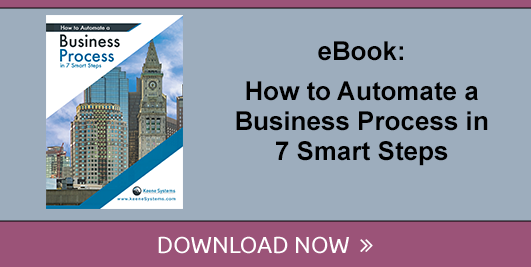Why Transform a Single-User Spreadsheet into a Multi-User Web App?
4 min read
Topic:
Automate Business Process
There was a time during the 1990s when most businesses still handled their important processes the exact same way: through a single threaded spreadsheet that could essentially only be used by a single person at one time.
Keep in mind that this was also during a period when 56k Internet connections were commonplace in companies everywhere. Emails were something you checked once a day, if that. Your mobile phone could do little more than make or receive calls - if you even had one at all.
In the years since we've upgraded to gigabit Internet connections, emails have become the dominant form of communication for modern enterprises and the smartphone you carry around with you in your pocket all day literally has more computing power than the technology that sent men to the moon in the 1960s.
Why, then, are we still dealing with those single-user spreadsheets simply because "that's the way things have always been done?" That excuse is absolutely not good enough any longer... if it ever was to begin with.
By taking those single-user spreadsheets and replacing them with sophisticated web applications, you can now allow multiple people to interact with critical data at the same time - all while creating an opportunity for better and more organic collaboration, too. Not only is handling information in this way inherently more secure than a spreadsheet can ever hope to be, but you also make the insight contained inside that data available anytime, anywhere and on any device with an active Internet connection.
All told, there are a wide range of different reasons why transforming your old spreadsheet-based processes into multi-user web applications is absolutely the right move to make - all of which are more than worth a closer look.
Eliminate the Limitations of a Spreadsheet with a Web Application
Obviously, the biggest reasons why you would want to transform a single-user spreadsheet into a multi-user web app is because you can now allow multiple people to interact with the data contained inside it at the same time, thus empowering collaboration across the board.
Think about it like this: even though you can technically share a single-user spreadsheet among multiple employees, they were never really designed to be handled that way. For starters, you can never be certain that everyone is working from the same version of that single document - leading to a situation where errors are an inevitability because one employee may now be making judgments based on old information.
Likewise, you have to depend on employees to manually share that data with the people who need it to do their jobs. If they don't, those employees are left in the cold at a time when they need to be as productive as possible.
With a web application, on the other hand, everyone always has access to the same information at the exact same time, guaranteeing that all key stakeholders are always on the same page. Likewise, a web application is always more secure than spreadsheets and they're also available anytime, anywhere and on any device - even smartphones and tablets.
Create a Better Understanding of How People Actually Work
Another one of the major limitations of spreadsheets is that they're not good at supporting and empowering an employee's desired workflow, simply because they were never really built for that purpose. They're designed to house basic information in a series of tables and cells - anything more complicated than that and you run into situations where even simple tasks begin to take far longer than they should.
Equally complicating things is the fact that, if users with different workflows try to collaborate on the same document, things only get more difficult. Take a spreadsheet being used for the purposes of inventory management, for example. Someone in accounting who needs to use that data to bill a client would obviously have an entirely different workflow than someone placing orders to make sure the materials are on hand that are needed to complete that upcoming job. A spreadsheet isn't going to support one of those unique workflows, let alone both of them - causing unnecessary delays and creating a situation where human error is an inevitability.
Something like a web-based work management system, on the other hand, can be designed to implement a company's unique workflow and processes in a far more organic way. Whereas a spreadsheet only has a very limited ability to apply business rules for data validation, a web-based application is far more robust - virtually eliminating the types of irritating and expensive data errors and quality issues you're used to dealing with, too.
But perhaps the biggest advantage that comes with creating a web application from a spreadsheet-based business process involves the deeper understanding of the business processes themselves. Not only can you finally understand the process, but you also get a far better sense of the interaction between the process steps, the required data and the people who need to act upon that data.
Yes, it takes care to implement a web application that not only captures all of the spreadsheet and human processes but that also improves and streamlines them. What needs to be captured is in the rolls and the needs of each actor in the process, all so that it can be mapped into the online system. But the long-term gains alone are more than worth the initial effort for most people.
Overall, this type of well-defined web application adds structure to a process at a time when it is desperately needed - structure that simply doesn't exist in a spreadsheet. Spreadsheets are somewhat of a "free for all" way to manage data, whereas web applications are more rigidly defined by design. This guarantees that your processes will happen exactly the same way every time, improving your ability to do higher quality work for your clients along the way.

Improving Operations, Productivity and Beyond
In the end, converting a single-user spreadsheet into a multi-user web app creates a plethora of distinct advantages that would be difficult, if not outright impossible, to get via other means. For starters, these online and multi-user web applications significantly improve operations thanks in large part to the "anytime, anywhere" access they offer to employees. Key stakeholders can now be just as productive out of the office working remotely as they can be at work - and that absolutely extends to employees who are currently in the field and on job sites as well.
Likewise, these web applications improve team productivity because everyone always has access to the information they need to do their jobs, regardless of where they happen to be. It also makes collaboration far easier because web applications can be designed from the ground up with custom workflows in mind.
But when you also consider the way that web applications can help meaningfully eliminate data error while also generating an almost unprecedented level of visibility into the organization, it's beyond clear why this is a step worth taking for most organizations. Not only does this help guarantee that you're no longer limited and prone to the dreaded human error, but it also helps your business scale at exactly the right pace - which is a very exciting position to be in, regardless of your industry.
To learn more about transforming a single-user spreadsheet into a multi-user web app, please download the eBook titled "How to Automate Business Process in 7 Smart Steps."


